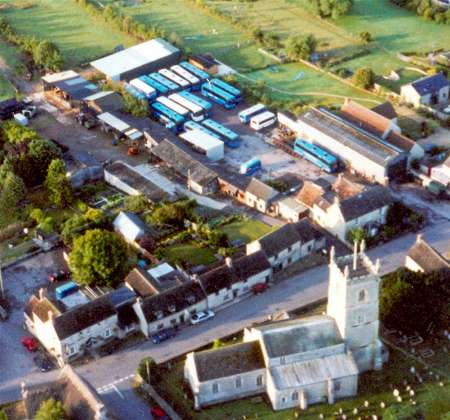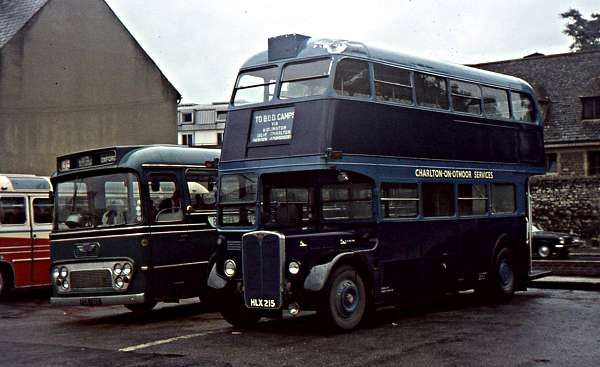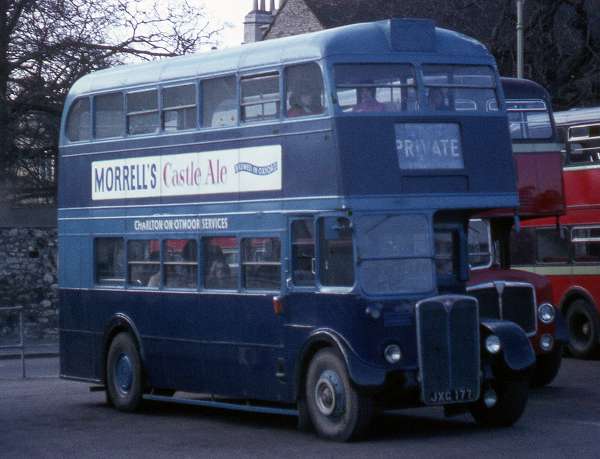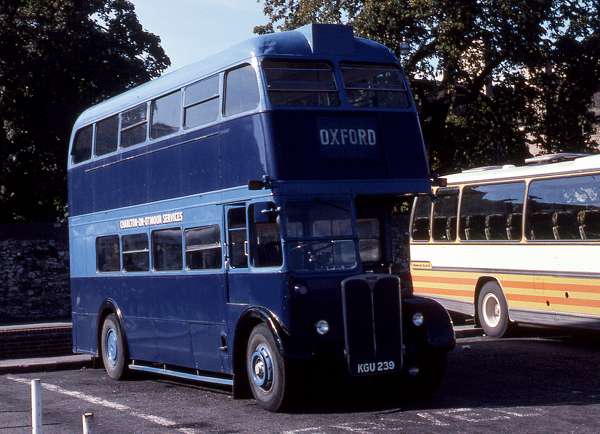Charlton-on-Otmoor Services
Charlton-on-Otmoor Services
Where I grew up we had no Leyland Tiger Cubs around. I used to think of them as rather characterless boxes on wheels, but when I drove a couple (only once each) for Charlton-on-Otmoor Services, NE of Oxford, in the early seventies, I came to appreciate what a delightful machine they are. The impression was confirmed a few days ago when FoKAB let me loose on their superbly restored example at Winchester, which had that wonderful Swiss watch-like precision that Chris Youhill finds in the Leyland PD1. Unlike some other underfloor buses, whose make I couldn't possibly mention, all three Tiger Cubs went where you pointed them.
Question: does anyone happen to recall the registrations or original operators of the Charlton vehicles? One had an Albion 5-speed gearbox and (I think) a Harrington coach or DP body; the other a Leyland 4-speed box and 2-speed axle and a plainer bus (?) body. Foolishly I didn't take down details at the time. A long shot, I know...
Ian Thompson
09/12/12 - 07:55
Funny you should mention this... I was only thinking about them the other day and their ?RT's which in blue, reminded me of Ledgards... or am I imagining all this. They seem to be still going in Kidlington, but perhaps only hire. Charlton on Otmoor always seemed rather romantic.... bit Harry Potter...but I have never been...does anyone know more? (Can't be difficult!)
Joe
09/12/12 - 14:56
And so was I, Joe. I recall they had a blue/white livery, whereas the normal livery, I thought, was two shades of blue.
Chris Hebbron
09/12/12 - 14:59
Joe you're absolutely right about the romantic image: the garage is in the middle of a quiet stone village on the edge of a small fen known as Otmoor. For some reason the company dropped the "on Otmoor" part of the name some years back, and I see that a Google search gives the address very misleadingly as "High Street, Kidlington" which is a very different suburban settlement three miles away. Perhaps the company is trying to shake off its rustic image...
Until the early seventies the fleet was wonderfully varied, and they were still buying Leyland Leopards and then Tigers until Leyland vanished. I'll try to get over there to see whether records exist of their fleet over the years.
I'm glad to say that they're still flourishing with private hire, school contracts and rural stage services.
Ian Thompson
10/12/12 - 07:20
An internet search provided two registrations for the Tiger Cubs:
332 BUA a Duple coach which became a caravan with a traveller until c1990
719 FHA a Harrington coach with a dorsal fin.
Both were new to Gliderways of Smethwick.
Dave Farrier
10/12/12 - 17:17
I donít suppose for a minute that this is a complete list, but Iíve found the following Tiger Cubs with Charlton Services:
VHA 325 Harrington C37C new 1954 to Gliderways, Smethwick, acquired 5/60
332 BHA Duple C37C new 1956 to Gliderways, Smethwick, acquired 9/62
416 DHA Harrington C41F new 1957 to Gliderways, Smethwick, acquired 12/65
719 FHA Harrington C39F new 1958 to Gliderways, Smethwick, acquired 9/68
Anyone noticing a pattern here?
Michael Wadman
11/12/12 - 07:09
Yes, as Ian says, the location is a very isolated and exposed part of Oxfordshire. Despite living in High Wycombe (not a million miles way) for fifteen year, I only ever visited them once - in their interesting and varied era.....
David Oldfield
12/12/12 - 11:21
Many thanks to Michael Wadman and Dave Farrier for their research into the Charlton-on-Otmoor Tiger Cubs, and David Oldfield's description of Otmoor as remote and exposed is spot-on. Looking out from the back of the C-o-O Services garage the nearest building of any kind is two-and-a-half miles away. The ghastly M40 motorway now skirts the fen to the NE, compromising its wonderful lonely character.
Ian Thompson
12/12/12 - 14:08

With all this talk of Charlton Services' depot, I suddenly remembered that I've got a photo of it. It's not mine and I can't remember where I downloaded it from but it may be of interest.
Michael Wadman
13/12/12 - 06:24
Re 332 BHA...here is a rather sad picture of it whilst in travellers hands and not long before it was scrapped www.travellerhomes.co.uk/
Richard Leaman
24/09/14 - 07:15
The articles on the above concern brought back some happy memories. Living in Kidlington and attending the Grammar school at Bicester in the late 40ís to early 50s., my everyday transport was Guy Arab BUD 65. This was new to Charlton and had a Roe body. More interesting was the Tiger TS8? which took me to my first motor racing event at Silverstone in 1950 for the British Grand Prix, the first season of the Drivers World Championship, and attended by the Royal family.
This Leyland had just been either re-bodied or at least re-trimmed and painted as it still had the smell of new paint and leather & moquette seating. It was beautifully done and we were instructed by 'Sonny' Honour, the proprietor/driver, to sit on newspaper on the roof and put same under our feet on the seats below! It was a gloriously hot day, May 13th. and we were fortunate in having the sunshine roof to give an excellent view of Woodcote corner, which was then the first corner after the pits. Raymond Baxter was commentating from the BBCís Commer van a few yards away and we were able to hear him on the coach radio, describe what was happening before witnessing it all ourselves. I understand that this lovely coach was lost in a fire at the garage soon afterwards. Also in the fleet were some ex Yorkshire Traction Titans with centre entrance and staircase which came via City of Oxford, a Bedford OWB, which was usually our return transport each day, an ancient Maudslay double decker with Willowbrook bodywork and a pre-war ex Coventry Daimler double decker.
Sonny Honour eventually retired and the business was acquired by Gordon Holder, one of his drivers and I believe it remains in that familyís hands to-day.
Thank you for very interesting website.
Derry Aust
23/01/15 - 16:22
In response to Derry Aust's comments 24/09/14, the Leyland you refer to is possibly AFM 517, a 1936 Titan TD4 rebodied by Thurgood and operated by Honour from 1945. This coach passed to Gordon Hodler in March 1955 and was destroyed in the depot fire of November 1956.
The former Oxford and Yorkshire Traction Titans were HD 4628, 4641 and 4807 new in 1932, which lasted until 1950. HD 4641 went for further use with Taylor, Bicester. There were (at least) two OWBs, BBW 149 and BBW 588.
Other vehicles I have recorded with Honour are REO UD 2010, Chevrolet UD 4051, Daimler VV 6593, Albion WL 8222, Leyland APG 325, Guy Arab CBW 600, and two Regents, FWL648/649. If anyone has any more info on vehicles (such as the Maudslay double decker Derry mentions) I'd love to know more!
Matt Bullock
24/01/15 - 07:27
Just to correct the last posting. The reg numbers given for the Titans are Dewsbury (HD) registrations making them presumeably ex Yorkshire Woollen District, not Yorkshire Traction (Barnsley HE reg)
Andrew Charles
05/02/15 - 06:50

I knew I had this - it was just a case of finding it!
Former London Transport HLX 215 is seen in August 1970 at Gloucester Green bus station, Oxford.
Bob Gell
09/01/16 - 06:55
Here are two more of the London Transport RT family that ran with Charlton-on-Otmoor Services.

JXC 177 was formerly RT 1414, and carried a Cravens H30/26R body. In July 1956 it was sold by LTE to A. E. Marsh of Harvington, near Evesham. This operator had traded as Black and White Coaches since at least 1935, but in the late 1960s a certain operating association of Cheltenham threatened legal action over the use of the name, and Marsh capitulated in the face of better funded brute force. Marsh disposed of JXC 177 around July 1961, when it passed to Charlton-on-Otmoor who used it for nine years, finally selling it on in September 1970. The story of the Cravens bodied RT3/4s revealed London Transport profligacy at its worst. They were delivered between September 1948 and April 1950, and were perfectly soundly constructed, yet withdrawals of the class began in May 1955 and all the red ones were gone were gone by April 1956; the last few green ones lasted until October 1956. Thus these modern, well equipped, high quality double deckers were taken out of service when the oldest were only seven years old, and the newest little more than five. The problem was their non standard bodywork, and, owing to gross over ordering in the post war period, very many brand new RTs and RTLs were sitting, unused, in store at that time. Although the RT fleet achieved a total of 4825 examples, the actual fleet operating on the road at any time was well short of this figure. Despite this embarrassment of riches, by 1955 London Transport was well on the way to ordering a fleet of RMs.

KGU 239, RT 1525 in the LTE fleet, was one of the batch of H30/26R RT3/3s bodied by Saunders of Anglesey. It was bought by Charlton-on-Otmoor in December 1968 and ran for that operator until December 1975, when it sadly went for scrap. The picture was taken in the summer of 1975 when the bus still looked very smart at 26 years of age. Despite the roofbox configuration, which LTE soon regarded as passť, the Saunders body was very highly regarded by Chiswick, many engineers being of the opinion that it excelled in quality the Park Royal and Weymann examples. The Saunders RTs were delivered between 1948 and 1952, and the last one was withdrawn from London service in March 1971. Incidentally, the two pictures, both of which were taken in Oxford, illustrate the variabilty of different makes of colour film. The shot of JXC 177 was taken on Agfacolor, that of KGU 239 on the much superior Kodachrome II. The same camera, my trusty British made Wrayflex II, was used on both occasions.
Roger Cox
09/01/16 - 12:23
This operator's name has long been familiar to me from reading enthusiast press over a long period, but I've only just become aware since reading this topic how interesting an operator it has been. Smartly turned out vehicles and, from the aerial photo, rather more extensive and tidy premises than one would imagine. The area, too, sounds idyllic, certainly before the motorway presumably blighted it to some extent.
Now, is my memory playing tricks, but wasn't there a minor difficulty in getting the new Saunders RTs off Anglesey because of height clearance on the Menai Straits bridge ?? I seem to remember reading somewhere that the tyre pressures had to be reduced "just in case" until the Mainland was safely reached.
Chris Youhill
09/01/16 - 17:52
I don't know about 'height' problems with getting over the Manai Bridge, but do recall that PRV (I think) offered their plans to Sauders-Roe when they got the contract awarded to build RT bodies. However, they declined and borrowed an RT to take their own measurements and do their own drawings. Charlton almost had the full range of postwar RT bodies, what with Weymann-bodied RT398 (HLX215), Craven-bodied RT1414 (JXC177)and Saunders-Roe RT1525(KGU239). Craven's bodies were only part look-alike bodies. The front was only superficially different by being flatter and having sharper side edges, but the body was five-bay and the rear sloped forward from the mid-point. Shame that the otherwise smart-looking RT's had roof-dome tree damage. I liked their livery.
Chris Hebbron
09/01/16 - 17:53
Yes, Chris, I've heard that tale about lowering the tyre pressures myself. The clearance under the roadway arches of the Menai Bridge towers is shown today as 15ft 6 ins, plenty enough for the passage of a 14ft 6ins double decker. The road surface was reconstructed to meet modern traffic requirements in 1999, but I don't think that the clearances were affected. I'm sure I've read somewhere that the "tyre pressures" story is folklore, but confirmation one way or the other would be useful.
Here are some links dealing with the Saunders Beaumaris plant, the first of which was penned by OBP contributor Stephen Allcroft.
http://middx.net/aec/board/viewtopic.php?f=4&t=463
http://www.28dayslater.co.uk/saunders-roe-anglesey-8-1-2010.t47372
This page has several pictures of Saro bus bodies - scroll towards the bottom:-
http://myntransportblog.com/2014/10/11/buses-saro-saunders-roe-1929-1964-isle-of-wight-uk/
An aerial view of the factory site may be found here:-
http://www.abct.org.uk/airfields/airfield-finder/beaumaris/
There has long been a view that the Saro Beaumaris factory was financially self sustainable, but the future of the Cowes plant took priority. Now, doesn't that resonate somewhat with the progressive inward collapse of a company called British Leyland firmly based in Preston?
Roger Cox
09/01/16 - 17:54
I've always wondered just what LT paid for each of these RT's when new, how much they sold them for to the dealers after only such a short time and little - if any - use, and how much the dealers sold them on for. I suppose except for maybe the latter, we will never know.
John Stringer
10/01/16 - 06:06
An interesting point, indeed, John. The evidence suggests that the post WW2 London Transport, successively LPTB, LTE and then LTB, found it impossible to distinguish between public money and water. (Not true today, of course - mains water is priced as liquid gold.) Having taken a decision in 1954 to replace its trolleybus fleet with diesel buses, London Transport then proceeded to sell off five to ten year old year old RTs and RTLs and pursued its massive RM purchase programme when very many brand new RTs and RTLs were still in store. One wonders who was monitoring this squandering of public resources.
Roger Cox
10/01/16 - 06:08
Many thanks everyone for these most interesting replies to the Saunders Roe access question - on balance therefore it would seem that the "soft tyres" is a wry invention by someone but who cares - at worst it was perhaps only a bit of quite innocent mischief.
From a personal angle I had a very soft spot indeed for the Cravens RTs which I found attractive and fascinating. Of course the fronts and rears were immediately noticeable as "different" but quite honestly I thought that the five bay arrangement had just as much appeal as the had the usual RT four bays, but in different way. Internally though the cappings and ceiling shapes were, if I remember rightly, unashamedly provincial and none the worse for it.
Just to put the record straight before the "Thames artillery" begin to fire, I also had the very highest regard for all members of the RT/RTL/RTW family which richly deserve the admiration which is virtually universally bestowed upon them.
Chris Youhill
12/01/16 - 08:45
Pity that the Saunders Roe website, 'myntransport blog etc'. only shows one RT picture and that's not a Saunder Roe body! The caption claims that it's an RT3/3 but the image is of a non-roofbox model. That's why we must never trust as Gospel truth what we read on the web.
One thing that I did find, however is the well known picture of a batch of Saunders RTs on delivery run over the Menai Bridge. This particular image is used on the cover of a book about the company. It shows very clearly the generous headroom on the bridge and no soft tyres in evidence!
View the book cover here.
Petras409
13/01/16 - 06:13
The RT error on the myntransportblog site is understandable. The original KLB 593 was a Saunders-bodied RT3/3. Not everyone would know that, thanks to the vagaries of the LT overhaul system, the bus in the photograph is unlikely to have any parts in common with the original KLB 593 other than its identity.
Turning to Roger's comments about the RM programme, I have read that the supposed justification was that London's bus drivers and bus passengers "deserve something special" to replace their trolleybuses. Such arrogance beggars belief unless you are actually in London to experience it. So I think it may be safely assumed that the answer to the question about who was monitoring this squandering of public resources is "someone in London".
Peter Williamson
27/04/16 - 05:53
The bus business at Charlton-on-Otmoor is said to have been started by Charles Knight in the 1930's. I have a report of a court case in 1933 where he states he owns one bus and is struggling to pay his way to run it. It became known as the Bluebell Line, probably because of the colour of the buses. By the second world war it was owned by Sonny Honour and whilst he was on active service in the Royal Navy his brother Alec ran the business. Later ownership passed to Gordon Holder and his family still run the business.
Nigel Lambert
Comments regarding the above are more than welcome please get in touch via the 'Contact Page' or by email at obp-admin@nwframpton.com
All rights to the design and layout of this website are reserved
Old Bus Photos from Saturday 25th April 2009 to Wednesday 3rd January 2024